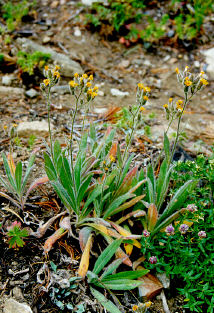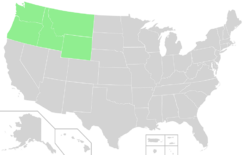Biology:Hieracium albertinum
| Hieracium albertinum | |
|---|---|

| |
| Scientific classification | |
| Kingdom: | Plantae |
| Clade: | Tracheophytes |
| Clade: | Angiosperms |
| Clade: | Eudicots |
| Clade: | Asterids |
| Order: | Asterales |
| Family: | Asteraceae |
| Genus: | Hieracium |
| Species: | H. albertinum
|
| Binomial name | |
| Hieracium albertinum Farr
| |

| |
| Hieracium albertinum distribution | |
| Synonyms | |
| |
Hieracium albertinum, known as western hawkweed or houndstongue hawkweed, is a species of the genus Hieracium that is very similar to Hieracium albiflorum with white flowers but differs in that the flower heads are clustered and the leaves, stems and bracts are covered in a thick layer of hairs. Standing 1 inch (3 cm) to 5 inches (13 cm) tall, it can be found blooming from June through August in forest clearings.[4][5]
Hieracium scouleri or Scouler's woollyweed, which has also been accepted as a synonym for Hieracium albertinum,[1][3][6]
There is some concern for Hieracium albertinum (and other native species) because while they are members of the genus Hieracium whose introduced species are often aggressively invasive or weedy, reproducing vegetatively from aboveground runners called stolons or from wandering underground stems called rhizomes, the less aggressive native hawkweeds reproduce only by reseeding.[7] While not listed as endangered, H. albertinum is somewhat threatened while its environment is overrun by the aggressive non-native family as well as being listed as a noxious weed due to its membership in the same genus.[8]
Distribution
Hieracium albertinum is native to North America and found east of the Cascades[4] in the states of Idaho, Montana, Oregon, Washington and Wyoming.[2]
References
- ↑ 1.0 1.1 {{citation | mode = cs1 | title = Hieracium cynoglossoides | work = Germplasm Resources Information Network (GRIN) | url = https://npgsweb.ars-grin.gov/gringlobal/taxonomydetail.aspx?448175 | publisher = [[Organization:Agricultural Research ServAgricultural Research Service (ARS), United States Department of Agriculture (USDA) | access-date = 2007-12-26 }}
- ↑ 2.0 2.1 2.2 Natural Resources Conservation Service (2007). "PLANTS Profile for Hieracium scouleri Hook. var. albertinum". The PLANTS Database. USDA, Baton Rouge, LA 70874-4490 USA.. http://plants.usda.gov/java/profile?symbol=HISCA. Retrieved 2007-12-18.
- ↑ 3.0 3.1 Flora of North America. "Hieracium scouleri in Flora of North America". Flora of North America North of Mexico (New York and Oxford: Flora of North America Association) 19, 20 and 21: 281, 282, 283, 289. http://www.efloras.org/florataxon.aspx?flora_id=1&taxon_id=250066957. Retrieved 2007-12-27.
- ↑ 4.0 4.1 Peterson Field Guide, Theodore F. Niehaus (1976). Pacific States Wildflowers. The Peterson Field Guide Series. Illustrations by Charles L. Ripper. New York: Houghton Mifflin Company. pp. 102. ISBN 0-395-91095-1. https://archive.org/details/fieldguidetopaci00theo_0/page/102.
- ↑ Farr, Edith May. 1906. Ottawa Naturalist 20(5): 109–110
- ↑ "Standard Report Hieracium cynoglossoides". USDA, Baton Rouge, LA 70874-4490 USA.. https://www.itis.gov/servlet/SingleRpt/SingleRpt?search_topic=TSN&search_value=37704. Retrieved 2007-12-26.
- ↑ Sarah Walker. "Weeds: Which Ones Should We Worry About?". Discovering Lewis & Clark. http://www.lewis-clark.org/content/content-article.asp?ArticleID=2087. Retrieved 2007-12-19.
- ↑ Germplasm Resources Information Network. "Invasive and Noxious Weeds". (GRIN) Online Database. USDA, ARS, National Genetic Resources Program.. http://plants.usda.gov/java/noxious?rptType=State&statefips=53. Retrieved 2007-12-26.
External links
Wikidata ☰ Q16983168 entry

